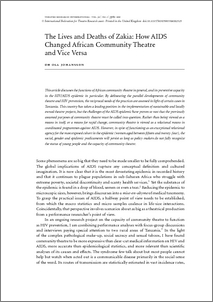The Lives and Deaths of Zakia: How AIDS changed African Community Theatre and vice versa.
Johansson, Ola
(2007)
The Lives and Deaths of Zakia: How AIDS changed African Community Theatre and vice versa.
Theatre Research International, 32 (1).
pp. 85-100.
ISSN 1474-0672
![[thumbnail of johansson2.pdf]](https://eprints.lancs.ac.uk/4228/1.hassmallThumbnailVersion/johansson2.pdf)

Preview
Abstract
This article discusses the functions of African community theatre in general, and its preventive capacity in the HIV/AIDS epidemic in particular. By delineating the parallel developments of community theatre and HIV prevention, the reciprocal needs of the practices are assessed in light of certain cases in Tanzania. This country has taken a leading position in the implementation of sustainable and locally owned theatre projects, but the challenges of the AIDS epidemic have proven so vast that the previously assumed purposes of community theatre must be called into question. Rather than being viewed as a means in itself, or a means for rapid change, community theatre is viewed as a relational means in coordinated programmes against AIDS. However, in spite of functioning as an exceptional relational agency for the most exposed cohort in the epidemic (women aged between fifteen and twenty-four), the social, gender and epidemic predicaments will persist as long as policy-makers do not fully recognize the status of young people and the capacity of community theatre.
Item Type:
Journal Article
Journal or Publication Title:
Theatre Research International
Additional Information:
The final, definitive version of this article has been published in the Journal, Theatre Research International, 32 (1), pp 85-100 2007, © 2007 Cambridge University Press. The article discusses the functions of African community theatre in general, and its preventive capacity in the HIV/AIDS epidemic in particular. By delineating the parallel developments of community theatre and HIV prevention, the reciprocal needs of the practices are assessed through certain cases in Tanzania. Tanzania has taken a leading position in the implementation of sustainable and locally owned theatre projects, but the challenges of the AIDS epidemic has proven so vast that the previously assumed purposes of community theatre must be called into question. Rather than being viewed as a means in itself, or a means for rapid change, as the discourse of applied theatre in Africa so often stipulates without case specific research, community theatre is here viewed as a relational means in coordinated and multi-sectoral programmes against AIDS. Young people exposed to AIDS in Tanzania primarily use community theatre to share information and experiences about HIV preventative practice. However, despite functioning as an exceptional relational agency for the most susceptible cohorts in the epidemic (women aged 15-24 years), the social, gender, and epidemic predicaments will persist so long as policy makers do not fully recognize the potential of young people and community theatre. The focus of the article is on the region of Kagera, in northwestern Tanzania, which is one of the few places in Africa where radically declined AIDS prevalence trends have been recorded. It is fair to assume that theatre has contributed to the decline, given that all districts in the region have an active scene of applied theatre. In a documentary on this hypothesis for the TV network CNN, (broadcast on World AIDS Day, 2004), Staying Alive, Johansson was consulted as line producer and chose to lay emphasis on a theatre group in Kagera that epitomises the positive intervening counteractions of HIV prevention. RAE_import_type : Journal article RAE_uoa_type : LICA
Uncontrolled Keywords:
/dk/atira/pure/subjectarea/asjc/1200/1213
Subjects:
?? visual arts and performing artsliterature and literary theorynx arts in general ??
Deposited On:
29 Feb 2008 13:51
Last Modified:
10 Dec 2025 21:38